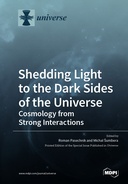Explore

Shedding Light to the Dark Sides of the Universe: Cosmology from Strong Interactions
0 Ungluers have
Faved this Work
Login to Fave
The theory of quantum chromo dynamics (QCD), an organic part of the standard model (SM) of particle physics, has been validated by many theoretical and experimental studies. The strongly coupled QCD dynamics controls colored particles’ (quarks and gluons) collective motion at large spacetime separations and the formation of colorless composite states (hadrons). While QCD theory and the related phenomenology aspects are being intensively studied in laboratory measurements, the possible connections of this important layer of knowledge to cosmology remain rather vague and largely unexplored. No doubt, the physical vacuum has been transformed many times throughout the lifetime of the universe and has affected its history through a sequence of events, such as the cosmic inflation, phase transitions, and the dark-energy-dominated expansion. Strong interactions could play an important role in some of these cosmological events. In particular, the emergence of a new state of matter called the quark-gluon plasma at the LHC is often suggested to provide an important source of empirical knowledge to what the universe looked like in the first few moments after the Big Bang. This Special Issue aims at creating an overview of the recent progress in these directions by focusing on the novel implications of quantum chromo, or more generally, Yang–Mills (YM) dynamics, to the physics of the early universe and critical phenomena in cosmology.
This book is included in DOAB.
Why read this book? Have your say.
You must be logged in to comment.
